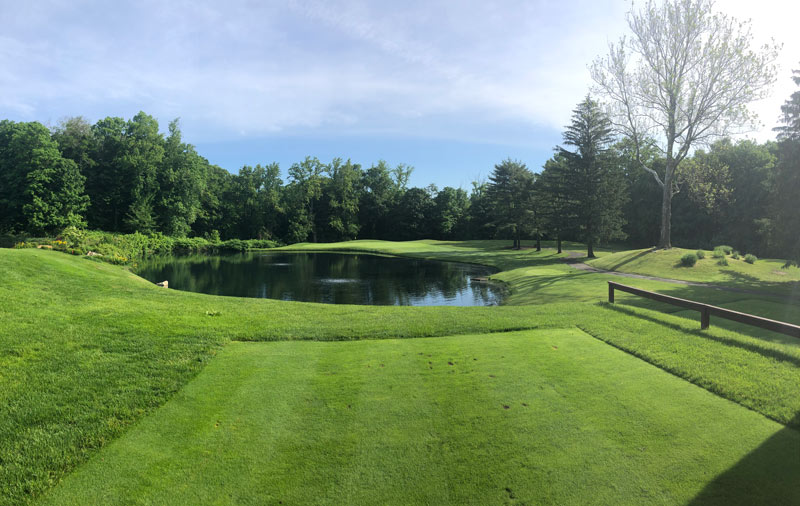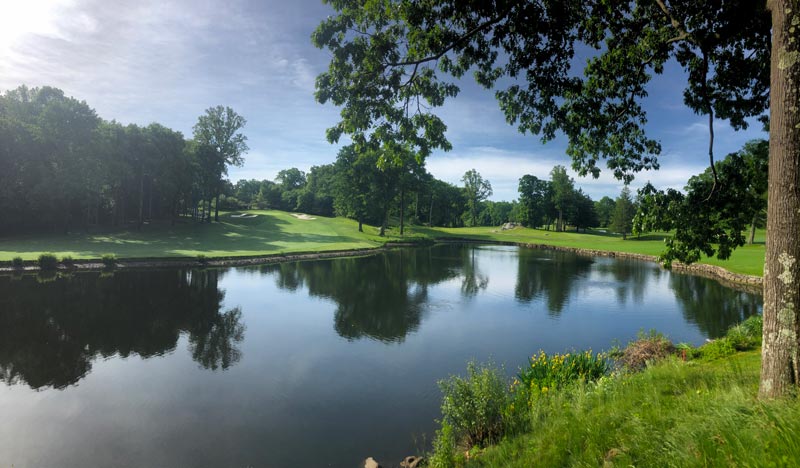
The pond on the par-3 third hole at Fairview Country Club in Greenwich, Conn. Superintendent Jim Pavonetti, CGCS, employs barley straw as a natural means of keeping the five ponds on the 18-hole private course looking pristine and algae-free. Photos by Jim Pavonetti
The visual appearance of water on a golf course can leave as much of an impression on golfers as the quality of the turf.
I remember following my 13-year-old daughter, who was usually a good junior golfer, during a U.S. Kids Golf tournament in Florida. The first hole on the course, a par 4, had a pond running parallel to the length of the fairway on the right side. Her use of the driver and 3-wood that day resulted in unintended extreme fades, and she took three different drops from the lateral hazard (now a penalty area) on the first hole.
I didn’t want to do the math to determine her score. Her face reflected misery when play of that hole was over, and, as she recalls, I told her to lose the expression that made her “look like her cat had died.”
The most prominent memory I have of that golf course, though, wasn’t my daughter’s performance. Instead, it was the algae-filled pond that consumed three of her golf balls on the first hole. Algae is common in golf course ponds and usually requires some type of preventive or curative action to deal with.
Jim Pavonetti, CGCS, superintendent at Fairview Country Club in Greenwich, Conn., has battled algae in the five ponds on his golf course for years. The water in the ponds that is not used for irrigation eventually drains out and flows into the Long Island Sound, so maintaining high water quality in the ponds is critical.
The golf course is irrigated with effluent water stored in four of its five ponds, and that water is higher in nutrients and creates an even more attractive growth environment for algae. As a result of this unique dynamic, Pavonetti, a 25-year GCSAA member, decided to try a non-pesticidal approach to algae suppression: barley straw.
Barley is to algae as kryptonite is to Superman. It has been referenced as a potential suppressor of algae in ponds for over 20 years.
When the water temperature in Fairview CC’s ponds reaches 65 F, Pavonetti uses a combination of weekly black dye treatments and monthly barley straw placement to prevent algae from forming. (The black dye keeps out certain ultraviolet sunlight necessary for algae to bloom.) Getting the barley out earlier in spring allows the straw’s decomposition to begin sooner, fostering more effective algae suppression.
As the barley decomposes, it releases compounds into the water that help prevent the proliferation of algae. However, barley straw is not effective as a curative treatment; it needs to be in place before algae begins to grow.
Pavonetti purchased submersible bait cages from a fishing supply to hold the loose barley straw. He has found that the straw is more effective if it is not tightly compacted within the container. The cages are placed out of sight at all stream entrance points to the five ponds on the property. There are eight entrance points — and thus eight cages — total. Pavonetti says the idea is to have the water plume through the cages to spread the beneficial bacteria the barley produces.

Fairview Country Club’s irrigation pond, located between the fourth and seventh holes.
In addition to the barley straw and black dye, each of Fairview CC’s ponds is equipped with an air diffuser-type pond aerator, which Pavonetti says enhances the overall effectiveness of this integrated pest management approach to pond maintenance.
Use of barley and dye has reduced the need for aquatic herbicides at Fairview CC by 90%, and has saved the club at least $9,000 annually. In the past, the ponds required up to nine herbicide applications per season. Now, curative control with herbicides is needed twice annually at most.
During hot, dry periods, when the water warms up and there is no inflow into the ponds, algae may begin to appear despite the barley’s presence. It is at these times that Pavonetti may see the need to apply a herbicide to the water. By using the combination of barley and dye, Pavonetti no longer has concerns about potential adverse effects of the presence of a herbicide in the pond water when irrigating the course, and his efforts have benefited the club economically and from an environmental stewardship standpoint as well.
Had the ponds on that Florida golf course my daughter played during the U.S. Kids Golf tournament been algae-free, I likely would have a better memory of that venue. That said, penalty areas filled with algae-containing water still absorb errant golf shots. I still fret over having to do the math after three shots on one hole ended up in the water. One in, two out. Three in, four out. Five in, six out, seven on the green. Two putt for nine. Darn!
Jack Fry, Ph.D., is a professor of turfgrass science at Kansas State University, currently working at the school’s Research and Extension Center in Olathe, Kan., and a 23-year member of GCSAA. This article originally appeared in the June 2020 print edition of GCM as Fry’s column, “What’s the Big Idea?”